ABSTRACT
In 2021, coal accounted for 25% of the world’s production of energy. Thermal coal was used to generate 36% of the global output of electricity, and metallurgical coal – in the form of coke - was used to make 70% of the world’s steel. This article, the second in a series of nine articles on the major sources of primary energy, reviews the distant and recent history of the coal industry, uses the SWOT framework to analyse the contribution of the industry to the global energy mix, and presents the International Energy Agency’s outlook for the industry over the coming three decades.
INTRODUCTION
Coal is a combustible, sedimentary rock, the bulk of which was formed from plant matter deposited in warm forest swamps during the Carboniferous and Permian periods (359–252 million years ago). Plants absorb energy from the sun through the process of photosynthesis and release this energy as they decay. In some places, the accumulation of soil and water deprives the dead plants of air, interrupting the decaying process. Over thousands of years, through a process called peatification, anaerobic bacteria decompose the material into peat. Then, over hundreds of millions of years, through the process of coalification, heat and pressure from overlying rock, soil, and water compact, harden, chemically alter, and metamorphose the peat into coal. Time and pressure continue to squeeze oxygen and other compounds from the coal, increasing its density and carbon content and enhancing its value to humans as a source of energy (Wikipedia, 2022).
Based on carbon content, coal is classified into four ranks, namely, anthracite (97-86% carbon), bituminous (86-45%), sub-bituminous (45-35%), and lignite (35-25%). The more carbon there is in the coal, the more heat it produces during combustion. Coal also contains variable quantities of elements besides carbon. A typical chunk of bituminous coal might comprise 84% carbon, 7% oxygen, 5% hydrogen, 2% sulphur, and 2% nitrogen (Coal education, 2022).
Coal is mined in two ways. Surface mining, which accounts for 60% of the coal produced globally, is practiced when the coal seams are less than 60 metres deep. Machines remove the overburden (top soil and layers of rock) to expose the seams so the miners can access them from above ground. Underground mining, also known as deep mining, is used when seams are 60-2,000 metres deep. It involves sinking vertical shafts and, from these shafts, digging horizontal tunnels that can be several kilometres in length. After the commercially viable coal has been removed, the disturbed rock and soil are returned and covered with topsoil so that grass and trees can grow again – a process called reclamation (Britannica, 2022).
Based on application, coal is divided into two types: thermal and metallurgical. Thermal coal, which comprises about 60% of coal consumption, is used to generate electrical power.
Metallurgical coal (also known as met coal) typically contains more carbon, less ash, and less moisture than thermal coal. In the form of coke it provides the energy used to produce 70% of the world’s steel. Metallurgical coal is also used in the production of aluminium, copper, and cement. It has fewer substitutes than thermal coal and a much smaller environmental impact.

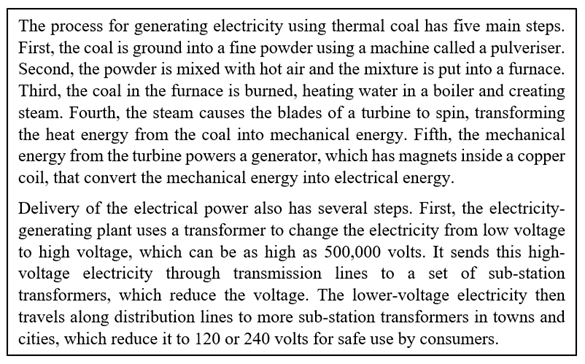
DISTANT HISTORY
Archaeological evidence indicates that early humans used coal for heating and cooking. The first commercial applications may have been in China, where coal was being surface-mined for use by households as early as 3500 BCE. There is also evidence that it was being mined in Fushun, north-eastern China, and used to smelt copper around 1000 BCE, and that it was being traded as a commodity during the Han dynasty (206 BCE – CE 220). In the 12th century, ironworks fueled by coal were widespread in China, with production of pig-iron in one region being greater than the whole amount produced annually in 18th century Britain (National Geographic, 2022).
The earliest reference to coal being used in Europe was by the Greek philosopher, Theophrastus (372-287 BCE), who wrote about blacksmiths in Italy using ‘strange stones’ to fuel their iron forges. During the Roman occupation of Britain (CE 43-410), coal was mined, used to smelt iron ore and heat public baths, and traded throughout England and in the Rhineland. By the end of the 13th century most of the currently known coal fields in Britain had been discovered and were being worked on a small scale (Wikipedia, 2022).
Recognition that coal smoke was detrimental to health led to a Royal proclamation being issued in 1306 ordering London-based artificers to use only traditional fuels such as wood and charcoal. However, the use of coal continued to expand throughout Britain, slowly in the 14th and 15th centuries, and then much more rapidly in the 16th century as the forests providing wood became depleted. In 1575, Sir George Bruce developed the first mechanised coal mine, to extract coal from under the sea using advanced techniques that led to his mine being considered ‘one of the industrial wonders of the age’. In 1610, he was knighted for this achievement. Paralleling the commercial success of coal, concerns over its use continued, with detractors commonly referring to it as ‘the devil’s excrement.’
In the 18th century a population boom, along with widening recognition that coal burned hotter and was cleaner than wood-charcoal, led to further rapid growth in demand. Initially, the industry could not provide matching supply, due to regular flooding of the mines. This problem was solved following invention of the steam engine in 1712 by Thomas Newcomen, who was working as an ironmonger, making products for coal-mine owners. His machine was quickly adopted across all large mines to pump out the unwanted water, allowing coal to be mined at greater depths.
The coal industry continued to expand rapidly in the 19th and 20th centuries. In the first half of the 19th century, thermal coal was used to power the rapidly growing fleets of steam ships and steam trains. By 1875, metallurgical coal in the form of coke had replaced wood charcoal as the fuel of choice for furnaces used to make steel. In the 1880s thermal coal began to be used to make electricity and by the mid-20th century was the main fuel used for electricity generation.
RECENT HISTORY
The share of coal in total energy consumption
Table 1 shows the global consumption of the major types of primary energy in 1965, 2000, and 2021. During 1996-2000, the average annual growth rate (AAGR) of coal was 1.5%, well below the growth rates of all other sources of energy. This led many commentators to conclude that coal was in terminal decline. It also led to a spate of articles on ‘peak coal’, with writers competing to identify the year in which the absolute volume of coal consumption would reach its maximum before levelling off and falling. However, during 2001-21, the AAGR of coal consumption was 2.3%, well above the corresponding rate for total energy, of 1.9%. As a result, coal’s share in energy consumption, which had fallen from 37.3% in 1965 to 25.0% in 2000, rose to 27.2% in 2021. The predictions of coal’s demise, if not wrong, were at best premature.
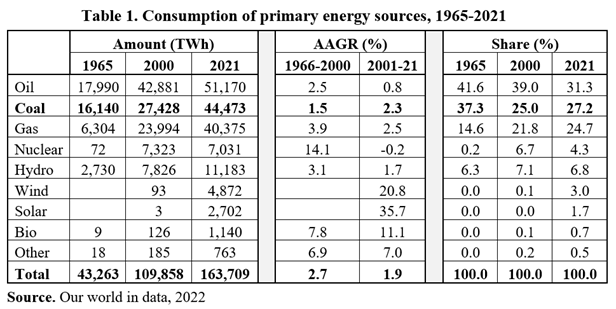
Consumption of coal by country
Table 2 shows the consumption of coal during 1965-2021 by the 10 countries that were the leading consumers of coal in 2021. It illustrates the huge impact that China and India have had on the global market. In 1965, China accounted for only 8.2% of global consumption. However, during 1966-2021, the AAGR of its coal consumption was 5.3%, almost three times the global average. By 2021, China’s share had increased more than sixfold, to 53.8%. Over the same period, India’s AAGR for coal consumption was 4.8%, causing India’s share in the global total to rise fivefold, to 12.5%. Other countries whose share increased, but from much lower bases, included South Africa, Indonesia, South Korea, and Vietnam. On the other hand, growth rates over the period were negative for the USA, Russia, and Germany and their combined share fell from 44.1% in 1965 to only 10.1% in 2021.
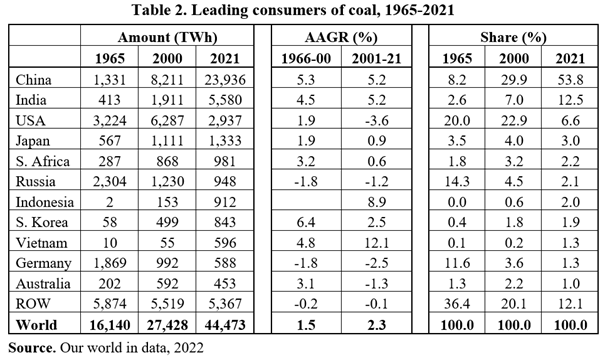
Production of coal by country
Table 3 shows the production of coal during 1965-2021 for the 10 countries that were the leading producers of coal in 2021. As with demand, there was a large change in the pattern of supply over the 56-year period. In 1965, the largest producers were the USA (22.0% of the total), Russia (14.1%), and Germany (11.7%). China’s share was 10.6%, India’s was 2.6%, and that of Indonesia was less than 0.1%. In 2021 China was the largest producer with 50.8%, followed by Indonesia and India with 9.0%, and 8.0%, respectively. Australia’s share rose fivefold to 7.4%. The shares of the USA and Russia fell to 7.0% and 5.5%, respectively, and that of Germany dropped to 0.7%. By 2021. Western countries had become relatively minor players in the global coal market.
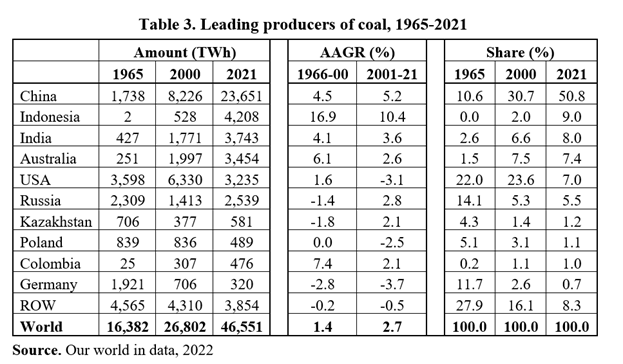
Reserves of coal by country
Table 4 shows known reserves of commercially viable coal for the world as a whole and for the 10 countries with the largest reserves in 2020. It also shows the ratio of reserves to annual production (R/P) in 2020, which indicates the number of years over which current production can be maintained before reserves are exhausted.
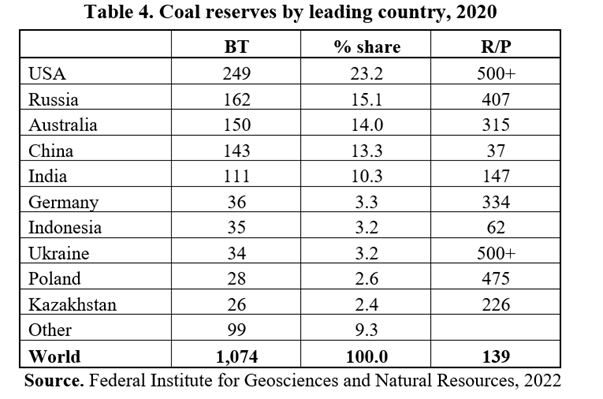
The USA, Russia, and Australia hold more than half the known reserves. At the current rate of production, their reserves will last several hundred years. However, China has only 13.3% of the total, and at its 2021 rate of production, these would be used up by 2057. This largely explains why China intends to phase out thermal coal in favour of renewables and nuclear energy. India is much better placed than China - its reserves of coal would last into the second half of the 21st century.
ANALYSIS
In this section, the author uses a partial SWOT (Strengths, Weaknesses, Opportunities, and Threats) framework to analyse the role of coal in the global energy mix. It is taken as a given that the world wants and needs energy to, for example, fuel cars, ships, and planes; generate electricity; and manufacture steel, aluminium, and cement. The question that will be considered is: Does coal play a net positive role in the energy mix? The focus is therefore on the effects of using coal rather than other primary sources of energy.
Criteria
The author adopts a Multi-Criteria Decision Making (MCDM) approach and, as a first step, divides relevant criteria into four categories: supply, cost, environment, and health. Supply focuses on availability (Are reserves sufficient to maintain the resource’s share in the total energy mix?), reliability (Is the energy accessible 24/7?), flexibility (Can production be increased and reduced in line with changes in demand?), versatility (Does the resource have uses other than in the supply of energy?), and security (Is the supply chain protected against major international political and transport risks?). The costs of providing energy from the resource tend to be analysed in either of two ways: in terms of current and capital costs; and at the various stages along the supply chain (e.g., production, transport, storage, refining, and distribution). The author has chosen the current/capital costs classification based on its greater simplicity. Environment includes climate, the quality of land and water resources, and biodiversity. In line with most discussion in the literature, air quality is included in health, along with accidents and other contributors to poor health.
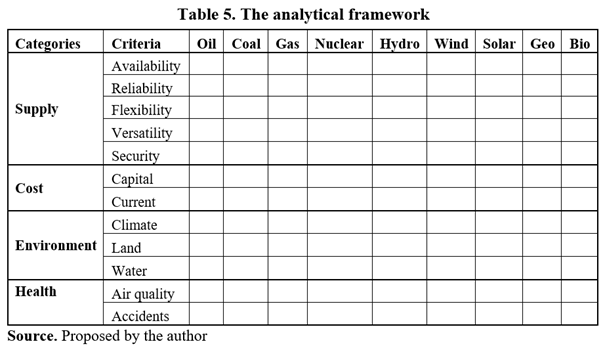
For a complete analysis, weights must be applied to these criteria, and quantitative values assigned to the effects in the matrix cells. These can then be multiplied, and the results summed and ranked. The question of weights has become highly politicised, and the author does not address it in detail in this article. However, a starting point for discussion might be: supply 30%, cost 30%, environment 30%, and health 10%. The effects analysis of the cells is more objective, and are the focus of the following analysis.
Strengths
Coal’s strengths relate to supply. First, global reserves are abundant – 139 years supply at the 2020 rate of production. Further, these reserves exclude coal deeper than 2,000 metres, assume that about half of the coal in underground mines must remain in place to provide supporting walls for the rock and earth above, do not consider new technologies that might overcome these limitations, and do not allow for discoveries of new deposits. Coal is a finite resource, but this will not be a constraint over the next few decades and the use of coal now is unlikely ever to have a serious effect on future options available to humans. Second, coal is reliable; it can be mined in almost any weather, it can be stored safely, and it can be used to generate electricity, smelt iron ore, or provide warmth at any time. Third, it is flexible (dispatchable); it can be used to ramp up production during periods of peak use, such as early evening, and can be withdrawn during non-peak periods such as early mornings and weekends. Unlike wind and solar, its use is not affected by daily or seasonal fluctuations in the weather. Fourth, coal is versatile. In addition to its role in producing electricity and major metals, it is used to generate oil and gas, provide activated carbon for water and air purification units, and supply inputs for the manufacture of chemicals, such as creosote oil, naphthalene, phenol, and benzene. Finally, being widely distributed geographically and easy to store, coal provides energy security for a large number of countries. This is especially so for Australia, whose reserves amount to 315 years of 2020 production.
Weaknesses
Coal’ weakness are in the areas of cost, environment, and health. Most comparative studies of the cost of energy from different primary energy focus on electricity. The share of electricity in final global energy consumption in 2021 was only 20.4%. However, it was 17.2% in 2010, has been increasing in almost all major countries, and is expected to exceed 30% by 2040. All major countries are aiming to raise the share of electricity in the secondary energy mix.
The cost of using electricity as a final source of energy can be divided into capital, operations & maintenance (O&M), transmission, and decommissioning. Capital costs tend to be low for oil and gas, moderate for onshore wind and solar, high for coal, and very high for offshore and nuclear. O&M - where the main differentiating expense is fuel - is negligible for renewables and solar, low for gas, and high for coal and oil. Overall costs for new capacity are site-specific but are falling rapidly in wind and solar as both experience with the relatively new technologies and the scale of the projects increase. It is widely expected that renewables will increasingly become cheaper as a source of fuel compared to coal.
According to the Intergovernmental Panel on Climate Change (IPCC), the average global temperature has risen by about 10C over the last century, and 30% of the increase can be attributed to coal. While there are considerable uncertainties about actual movements in global temperatures, the part of any movement that have been caused by humans, and the proportion of human-induced climate change that has been due to coal and other fossil fuels, there is widespread support for the view that the share fossil fuels in the energy mix should be reduced.
The extraction, transportation, and handling of coal release coal dust into the atmosphere. The burning of coal releases particulates, sulphur and nitrogen oxides, trace elements, and organic compounds. These affect the lungs, the immune system, the heart, the brain, the reproductive system, and the DNA of miners, other workers in the industry, and residents of nearby communities. It is estimated that deaths each year from coal amount to about 370,000 in China, 170,000 in India, and 50,000 in the USA (Our world in data, 2022).
OUTLOOK
Every year, the International Energy Agency (IEA) produces a World Energy Outlook (WEO) Report, which includes projections of the long-term demand for coal under three different scenarios: a Stated Policies Scenario (SPS), which reflects currently legislated policies; an Announced Policies Scenario (APS), which includes announced targets and policies; and a Sustainable Development Scenario (SDS), which assumes that the key Sustainable Development Goals of the United Nations will be achieved. The APS is perhaps the most plausible of the three scenarios. It projects that the global demand for coal will rise by 8.1% during the 2020s but will fall by 4.0% in the 2030s and 6.1% in the 2040s. In 2050, global consumption will be 2.6% below its 2020 level. Under the more ambitious APS, the growth of coal consumption will be only 0.4% in the 2020s and will be minus 2.0% in both the 2030s and the 2040s. Under this scenario, global consumption in 2050 will be 30% lower than in 2020 (IEA, 2)21).
REFERENCES
Birol, F. (2021). IEA. The World Energy Outlook, 2021. https://www.iea.org/reports/world-energy-outlook-2021
Editors (2022). BP’s Statistical Review of World Energy (2022). https://www.bp.com/en/global/corporate/energyeconomics/statistical-review-of-world-energy.html.
Editors (2022). Coal study guide. https://www.energy.gov/sites/prod/files/Elem_Coal_Studyguide.pdf
Editors (2022). Energy education. https://energyeducation.ca/encyclopedia/coal_types.
Editors (2022). Energy explained. https://www.eia.gov/energyexplained/coal.
Editors (2022). Energy data. https://ourworldindata.org/grapher/energy-consumption-by-source-and-region,
Editors (2022). BP’s Statistical Review of World Energy (2022). https://www.bp.com/en/global/corporate/energyeconomics/statistical-review-of-world-energy.html.
Kentucky coal education (2022). What are the chemical & mineral compositions of coal? http://www.coaleducation.org/q&a/what_are_the_chemical.htm.
Kopp, O. (2022). https://www.britannica.com/science/coal-fossil-fuel.
Pletcher, K. (2022). Rhondda. https://www.britannica.com/place/Rhondda
Turgeon, A., & Morse, E. (2022). https://education.nationalgeographic.org/resource/coal Wikipedia (2022). https://en.wikipedia.org/wiki/History_of_coal_mining
BIOGRAPHY

Angus Hooke is Emeritus Professor, Senior Scholarship Fellow, and Director of the Centre for Scholarship and Research (CSR) at UBSS. His earlier positions include Division Chief in the IMF, Chief Economist at BAE (now ABARE), Chief Economist at the NSW Treasury, Professor of Economics at Johns Hopkins University, and Head of the Business School (3,300 students) at the University of Nottingham, Ningbo, China. Angus has published 13 books and numerous refereed articles in prestigious academic journals.




